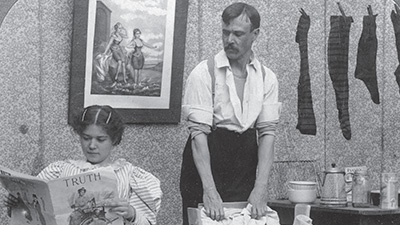Women’s Rights
Teacher Resources
Driving Question: How did women’s roles and societal perceptions shift during the long nineteenth century?
Women weren’t just living through the changes of the industrial era—they were pushing change forward. Around the world, communities of women challenged injustice in their personal lives and in the public sphere.
Learning Objectives:
- Examine the networks of women’s rights activists and compare how their work transformed societies around the world.
- Use the historical thinking skill of comparison to evaluate the similarities and differences between women’s experiences as they fought for suffrage.
- Utilize the historical thinking practice of claim testing to comprehend the transformation of gender and class relations in the long nineteenth century.
Vocab Terms:
- activism
- colonialism
- gender
- patriarchal
- reform
- suffrage
- traditional
Opener: Women’s Rights
To teach this lesson step, refer to page 3 of the Lesson 4.6 Teaching Guide.
Browse the Openers and Closers Guide to get tips for using these activities effectively to start and end your lessons.
Reading this primary source will help you understand how ideas around gender and women’s roles in society were evolving during the long nineteenth century.
Women’s Suffrage Movements
To teach this lesson step, refer to page 3 of the Lesson 4.6 Teaching Guide.
This Comparison One-Pager is your one-stop resource for this fundamental historical thinking skill.
Explore how the fight for women’s voting rights took shape in different countries. You’ll compare movements to see how context shaped goals and outcomes.
-
Guiding Questions
-
Before you read
Preview the questions below, and then skim the article. Be sure to look at the section headings and any images.
While you read
Look for answers to these questions:
- What is suffrage, and what sparked the women’s suffrage movement in New Zealand?
- Why did the UK grant women over 21 the right to vote in 1929?
- Why was suffrage in India slower to develop under British rule?
- Which women were excluded from voting in North America before the 1960s?
- What helped expand women’s suffrage in Latin America and Africa?
After you read
Respond to this question: How do you think gaining the right to vote changed life for women in different parts of the world?
Gender Roles
To teach this lesson step, refer to page 9 of the Lesson 4.6 Teaching Guide.
Get ready to teach this essential historical skill with the Comparison One-Pager, packed with helpful strategies and guidance.
Explore how gender roles shifted during the nineteenth century. You’ll examine how class affected women’s experiences and test claims using evidence.
-
Guiding Questions
-
Before you read
Preview the questions below, and then skim the article. Be sure to look at the section headings and any images.
While you read
Look for answers to these questions:
- What were Victorian gender roles? How did they spread globally?
- Who were the “new women” in Europe and America? What did they represent?
- How did imperialism affect women’s lives in Asia and Africa?
- How did women in Nigeria use traditional roles to resist colonial rule?
- How did nationalism and socialism offer both opportunities and limits for changing gender roles?
After you read
Respond to these questions: How did ideas like nationalism, socialism, and empire help change gender roles? What limited those changes?
Closer: Women’s Rights
To teach this lesson step, refer to page 14 of the Lesson 4.6 Teaching Guide.
Closers are a great way to informally evaluate student understanding. Read more about that in the OER Project Assessment Guide.
In this unit, you’ve examined how industrialization and reform reshaped societies and identities. Now, reflect on how these changes influence your understanding of the modern world.
Writing: Industrialization Impacts
To teach this lesson step, refer to page 15 of the Lesson 4.6 Teaching Guide.
In this writing activity, you’ll use evidence from sources to support an argument that responds to the question: How did industrialization impact society during the long nineteenth century?
Work at Home
To teach this lesson step, refer to page 15 of the Lesson 4.6 Teaching Guide.
What can washing clothes in Victorian England show us about life back then? A lot! Let’s put a load in and see what comes out in the wash!
-
Guiding Questions
-
Before you watch
Preview the questions below, and then review the transcript.
While you watch
Look for answers to these questions:
- Why was it important to soak and beat your clothes for at least 30 minutes?
- Why were household chores like the washing done by women and girls?
After you watch
Respond to this question: How does learning about Victorian washing machines help you understand class and gender roles in this era?








